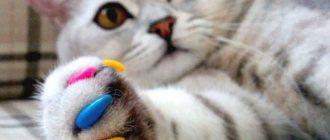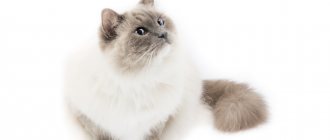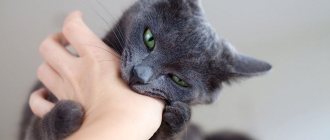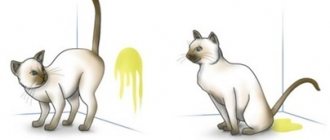Why do cats sharpen their claws?
There are many reasons explaining the natural behavior of representatives of the feline family:
- Physiology. The claws are constantly growing, and over time the old nail plate is replaced by a new, sharper and stronger one. During this, the animal experiences discomfort and inconvenience, as hangnails may form on the paws. To get rid of unpleasant sensations and to speed up the process of changing claws, cats sharpen them on what they consider to be fairly hard surfaces.
- Cats fight for territory. Veterinarians and zoologists say that the tips of a cat's paw pads contain sweat glands necessary for unique scent marks. Thus, the cat makes it clear that he is the boss here.
- This is a kind of fitness to maintain physical shape. While sharpening its claws, the cat uses many muscles, thereby subjecting them to considerable stress.
- Fighting stress. Perhaps damaged furniture and tattered wallpaper are the result of a nervous shock the cat has experienced, or he is simply trying to attract your attention.
Sprinkle with water
Once your cat has mastered the scratching post, start moving her away from places where her claws should not be sharpened. A completely painless repellent is to spray water from a spray bottle at the moment when it begins to scratch the furniture. The cat will associate unpleasant sensations with its actions and will stop approaching this place.
Cats' Favorite Surfaces
Probably, upholstered furniture most often suffers from cat claws. It is not for nothing that cats choose armchairs, poufs or sofas as victims; their choice is not accidental. If the animal lives in a natural environment, the main accessory for manicure procedures is tree bark; in an apartment, the cat has no choice but to use an alternative option - upholstered furniture.
In addition, purrs do not mind testing window curtains, carpets, cabinet furniture facades, etc. for strength. There are also surfaces that cats are not interested in:
- ceramic tile;
- stone;
- plaster;
- plastic;
- linoleum;
- parquet;
- laminate and others.
Unfortunately, the materials listed are not used to make furniture, so your furnishings are still at risk. To somehow protect the upholstery or hide existing damage, you can use protective covers or restore the furniture. Next, we will talk about methods that allow you to wean a cat from tearing up furniture and are aimed at re-educating it.
Reasons why a cat scratches furniture
First, you need to consider the reasons why your four-legged friend decided that the furniture could be damaged.
- Nail sharpening is extremely important for cats because it is not only important to keep the claws in good condition, but also because it is an exercise aimed at strengthening the muscles;
- Fluffies express their emotional state in this way;
- This process is also necessary in order to mark its territory, since there are sweat glands on the paw pads, they leave an odor;
- If your pet scratches a piece of furniture that you use most often, then he may simply be expressing his love and, again, marking you, showing that you belong to him;
- This is a simple necessity that will not be affected by anything, not even your screams.
You just have to get creative if you want to keep the fittings in your home safe and sound.
Spray bottle in the fight against cat claws
You can try to stop your cat from scratching the sofa using a regular spray bottle filled with clean water.
It is a well-known fact that representatives of the cat breed do not like water and avoid contact with it in every possible way. This can be used in the fight to preserve the normal appearance of your apartment. As soon as the purr decides to sharpen its claws on your favorite sofa, direct a stream of water at it and thoroughly wet the scoundrel.
Advantages of the method:
- works after systematic punishment;
- does not require the purchase of special devices;
- does not come with any costs.
Minuses:
- the technique is effective only when you record the cat’s intention and immediately punish it;
- As soon as the smart cat is left unwatched, he will continue his dirty deed without delay.
How not to wean
It is better not to use these weaning methods if you want to achieve a positive result and remain on good terms with the cat:
- Spray bottle with water. To scare away a cat, taking advantage of its dislike for water procedures, water is sprayed on its face from a spray bottle. This method may work, but the animal will begin to associate this unpleasant event with your personality and will try to take revenge.
- Scream. Remember that you can scold a cat, but you cannot shout at it. Never scream when you stop a cat with a voice command. Screaming will scare the animal, but will not bring the desired result.
- Physical punishment. You can't hit cats! The animal will get scared, harbor a grudge, and try to take revenge.
- Late identification of the problem. You can scold a cat only when you take it by surprise at the site of vandalism. If the wallpaper is already torn off, the furniture is scratched, there is no point in expressing your attitude towards this. The animal will not understand why you are scolding it.
Cats don't like strong scents - we use this against them
If spraying with cold water does not bring results, you need to look for a new effective method that will help bring some sense to the animal. Many breeders use scents in this matter, for example, a bright citrus aroma.
In some cases, it is enough to put a slice of lemon next to your favorite place for manicure and the cat will not repeat his old mistakes for a long time, leaving his favorite carpet alone. You can use citrus essential oils, but under no circumstances apply them to the damaged area, so that you don’t have to figure out how to remove the resulting stains. Specialized veterinary stores have special repellent sprays and fumigators:
Pros:
- efficiency 99.9%.
Minuses:
- aroma traps will have to be constantly updated, since natural odors quickly disappear.
Rules for caring for a cat
In order for communication with a small cat to bring mutual satisfaction, it is worth knowing the rules of caring for a four-legged cat, which will not require much effort, but love and patience.
Love your pet!
- The first and main condition is personal space, a place for the animal: this can be a house or bedding on which it will sit and sleep. At the same time, you must not forget to shake out dust and wool from it, and also wash it periodically.
- Feed should be varied, nutrition should be balanced.
- If a cat lives in an apartment, from the first days of his life he needs to be trained to use a litter box.
- The coat requires care, especially if the cat is a long-haired breed.
In parallel with accustoming the cat to the scratching post, wean the cat from the places it habitually scratches.
These simple tips will help you raise a gentle, obedient and neat animal that will thank its owner for its care with a gentle purr.
Scotch tape will help preserve furniture
If for some reason the previous two methods did not work or did not suit you, try retraining the cat using regular double-sided tape.
The fact is that cats really don’t like it when their paws stick to something, so they won’t sharpen their claws on a sticky surface. To test this method in practice, stick a sufficient amount of tape to the damaged side of the furniture, curtain, or window sill.
Pros:
- the cat will not want to deal with the unpleasant sticky surface and will lose interest in it;
Minuses:
- Because of the sticky tape, the interior will, of course, not benefit; you will have to endure some inconveniences until the bad habit is eradicated.
Protective coatings
Prudent owners think in advance about how to protect walls, floors, and upholstery from scratches:
- Clean cats do not like sticky surfaces and will not touch them with their paws. Table legs, armrests, and edges of window sills are covered with double-sided tape. To protect against scratches, adhesive tapes are produced. Sticky Paws - they are invisible, adhere firmly to fabric surfaces, and do not leave marks.
- Upholstered furniture is covered with covers made of strong, scratch-resistant fabric; they are easier to clean and replace than a sofa or armchair.
- During repairs, the walls are covered with durable, smooth wallpaper: vinyl, paintable, liquid, fiberglass. The corners are covered with plastic panels; they are easier to replace than to re-glue the walls. Cats are not interested in decorative plaster, ceramic tiles, linoleum, or durable laminate.
- The areas where the cat is targeting are temporarily covered with aluminum foil: animals do not like smooth sliding surfaces. Cats do not like packaging film with air bubbles; their claws sink into it and get stuck.
Repellent sprays with a motion sensor have appeared on sale. When cats approach, they make a sound or release a stream of air or water. This remedy is not used for animals with unstable psyches.
Trimming or declawing
You can get your favorite furry manicure done at a pet beauty salon, use the services of a groomer or veterinarian, or try to master a simple procedure yourself at home. For this you will need a nail clipper.
One of the simplest answers to the question of how to stop a cat from scratching furniture with its claws is help with manicure. If you decide to carry out the manipulation yourself, be patient, ask someone to hold the animal, act with extreme caution so as not to injure the delicate skin of the pet.
Those who have repeatedly unsuccessfully tried to wean a cat from the harmful habit of ruining an apartment often use a drastic remedy to prevent the cat from tearing up the furniture - declawing. From a common sense point of view, this is a barbaric procedure, as a result of which your animal will lose an important part of its body, will not be able to walk outside, will not be able to protect itself from the enemy and will be forced to go through a long rehabilitation period.
Say sharply: “You can’t!”
First, try to influence psychologically. As soon as your cat gets the idea of scratching furniture or walls, loudly and sharply say “No!” or “You can’t!” You can even clap your hands or hiss so that the cat immediately reacts to the sharp sound and changes its mind about doing its job. If you are persistent and notice her intentions in time, then you won’t even need to use our other 6 ideas. If you missed the moment or the method did not work, read on.
Install a scratching post at home
To preserve the original appearance of upholstered furniture, manufacturers of veterinary products have come up with special scratching posts that purrs can use for their intended purpose, without fear of being punished. Veterinarians and breeders recommend accustoming your kitten to a useful device from childhood, so you can be sure that the sofa and other upholstered furniture will definitely not interest the fluffy one.
The choice of scratching posts in the pet store is huge:
- in the form of a house or play complex;
- corners for protecting corners of furniture, connecting walls;
- in the form of a straight board, wave;
- in the form of a column.
These can be floor or wall structures, simplified products in the form of fabric-upholstered boards, or multifunctional houses with a sleeping area and several play compartments. Scratching posts are made from different materials; sesal, jute, natural wood, and carpet are used in production. Whatever option you choose, the main thing is to accustom the cat to it as early as possible. This can be achieved by using a variety of treats to attract attention, including catnip treats.
You can also apply special products to the surface of the scratching post to correct the behavior of the fluffy.
Selection and training to a scratching post
The easiest option is to purchase a scratching post, maybe even several, so that the cat has a choice. Scratching posts are made from sisal, hemp or burlap - natural materials are attractive to pets and do not cause allergic reactions.
It is important that the scratching post is secured and does not wobble or fall.
In modern stores there is such a variety of devices that it makes your eyes wide open. How not to get confused and choose something that your pet will like and fit into the interior?
There are several types of scratching posts:
- Wall-mounted. The stationary scratching post looks like a board and is mounted on the wall. It is covered with sisal rope or canvas. For animals that prefer to crawl into corners and walls, corner scratching posts were invented. They consist of two planks.
- Floor-standing. They are divided into volumetric and flat. Flat ones resemble ordinary boards of various shapes. They are installed on a flat, smooth surface, and the pet claws against it, as if against a carpet or wall. Volumetric sharpeners look like posts attached to a wide base.
- Complex. A whole set of multi-level sharpeners looks like a miniature sports field. Typically, such structures contain columns, shelves, and houses. In the complex, the cat can not only sharpen its claws, but also play and sleep.
You don’t have to buy a scratching post, but build it yourself: it doesn’t take much time or effort.
For some animals, a log or a good piece of wood without splinters is enough. The main thing is to take into account the pet’s attraction to the type of surface (fabric, rope, wood) and the type of plane (horizontal or vertical).
Be prepared for the fact that the cat will not immediately recognize the scratching post: the acquaintance may take several days. Move the cat's paws along the rough surface, slightly pressing on the pads so that the claws come out. The animal will not immediately understand that the device is convenient for sharpening its claws.
As soon as the cat starts tearing up the furniture, pick him up and carry him to the scratching post. Let him complete the action himself: then the skill will be firmly established.
Training will take from 1 to 3 weeks on average. Make it a rule not to let your cat finish scratching the furniture by immediately taking him to the scratching post. Don’t forget about praise and other protective measures - trim the cat’s claws and spray restricted areas with repellent spray. A set of measures will speed up the education process.
How to stop your cat from scratching furniture using alternative methods
If you have tried all of the listed methods in your arsenal and none of them have proven effective, you need to try alternative methods of combating a bad cat habit:
- Try putting special anti-scratch guards on the cunning pest's claws. Each claw is fitted with a silicone attachment, which is attached to the surface of the claw with glue, which prevents accidental removal of the accessory.
- Furniture covers. To protect your favorite bed, new sofa or comfortable chair in which you like to drink hot tea and watch the evening news from the merciless claws, you can buy protective furniture covers, the material of which will not be of interest to the four-legged pest.
- Considering that cats choose only certain materials for sharpening their claws, you can replace the damaged material with something that will not arouse the purr's interest. So, in place of the destroyed wallpaper, you can put tiles or cover it with plastic panels.
- Try not to leave your cat alone with an object that she mistook for a scratching post; raising pets has not yet been canceled.
Unlike surgical declawing, the pet does not experience pain or significant discomfort, quickly gets used to the changes and eventually stops paying attention to the attachments. The only thing a cat with such a manicure cannot do is jump to a considerable height and damage your furniture, which means that the goal can be considered achieved. After the claws grow back, you will have to repeat the procedure of gluing new pads.
What to do if nothing helps
To solve the problem, if it cannot be solved in other ways, you can use another option that involves unexpected loud sounds to scare away.
Go to radical methods if conventional ones do not help.
Such a factor could be:
- a loud dissatisfied shout: “You can’t!”, “Scram!”;
- the sound of a store-bought rattle;
- use a homemade “scarer” made from a tin can with a handful of coins placed in it.
Use claw covers.
Some people advise using inflated balloons to block the road to a forbidden place. However, not everyone approves of this method, so the choice is up to the owner.
General tips or how to stop a cat from tearing up furniture
Do not forget that representatives of the cat family are very smart and resourceful. To retrain an animal, you will have to “have a heart-to-heart talk with it,” be affectionate and attentive, carefully pointing out errors in behavior.
Aggression and physical punishment do not lead to a positive result; it causes stress in the pet and only aggravates the situation. As for education, you need to adhere to the following principles:
- make sure that the cat does not experience stress, surround it with love and sincere care;
- set the boundaries of what is permitted and do not allow them to be crossed;
- Do not hit a defenseless animal, this is a form of cruelty and is absolutely unacceptable.
We talked about how to wean a cat from tearing up a sofa and other interior items, and dwelled in detail on popular methods of combating a bad habit. You just have to choose which of these options you will use.
Check out the toys, teasers, and treats that will keep your furry pets occupied:
Stopping unwanted behavior
Scare away with loud sounds
This remedy can be effective on cats that are very timid by nature. At the moment when the pet approaches the crime scene, you can loudly and sharply shout “No!”, “You can’t!”, “Scram!”, make a sharp noise with something (a container with coins or stones), and clap your hands. A timid furry friend will jump to the side. It is advisable to then take the pet in your arms, relieving slight fear, and sit it next to the scratching post.
Sharpening her claws is an instinctive behavior, so there is no point in scolding her. It is also not advisable to scold her near the scratching post or when she sharpens her claws on it. It should evoke only positive emotions in the animal.
Inflated balloons attached nearby will perfectly scare a cat away from the furniture, which it will definitely touch during sharpening. The animal will experience unpleasant sensations from a bursting balloon. This will scare the pet away and make you think next time whether it’s worth approaching.
Repelling with liquids
Everyone knows that cats for the most part are not fans of water and everything connected with it. Find or purchase a spray bottle, fill it with water and place it near the place where the furniture was damaged. Every time your pet walks past furniture or gets ready to sharpen its claws, spray it with water. It is advisable to spray before the start of the procedure so that she develops unpleasant sensations associated with this place and the planned actions. If you spray her after the deed, she will most likely not understand the reasons for attacking her. This product is harmless to cats.
Try to spray so that water does not get into the animal's ears. Otherwise, water that gets into the ear can cause inflammation of the ear organs - otitis media.
You can add tangerine, orange or lemon oil to the spray bottle. Their smell is the most unloved for furry friends. Spray the furniture with it and use it every time your pet tries to tear up the furniture. The advantage of this product will be not only the animal being scared away from the furniture, but also the apartment being filled with a fragrant smell.
Clue! Remember to shake the spray bottle before use, as oil and water tend to separate.
At a pet store you can purchase a device with a motion sensor with a built-in gas cartridge. It should be installed near the place of regular damage, pointing directly at it. As soon as the animal approaches it, the device will work and spray with a repellent. An ideal remedy for teaching a cat not to tear up furniture in the absence of its owners. The downside is that it’s not a cheap pleasure.
You can also separately purchase a product in pet stores in the form of a spray that helps prevent your cat from tearing up furniture. True, many owners note that they are ineffective.
Alternative option! You can place the dried zest of any citrus in cotton bags and place it near the spoilage area. Various strong-smelling spices (ground chili pepper, suneli hops, coriander) are also good deterrents, which can also be placed in bags in crime areas.
Distracting
Often it is enough to simply distract the animal’s attention from its favorite furniture. You can throw a toy, give a treat, pet it. Pets usually like all this, so they can easily distract attention.
You can also distract attention with a board that will imitate your favorite walls, if you stick the same wallpaper on it and put it in the same place, covering the real one. There is a high probability that the animal will sharpen its claws on it. After some time, you can gradually begin to move this board to a place where it will not be an eyesore. The animal will move with it. The main thing is not to rush in this matter.
Common Mistakes
No matter how much it may seem to the breeder that he is right, there are nuances that not only do not help, but also create certain obstacles in weaning the cat from stripping furniture upholstery and wallpaper.
Physical punishment and screaming
Cats have excellent memory. No matter how much they are shouted at, they understand the intonation. Considering that they cannot do without scratching and sharpening their claws, pets will continue to solve their problems there, but at the moment when the owner turns away. Other representatives of the cat family will do this on purpose.
Throwing objects
You should not throw objects at your pet. This will not help the matter, and in addition, it may harm the animal. For example, an object thrown at it may someday hit the target and injure the cat. The point here is not so much in education, but in its absence.
Use of aggressive chemistry
Not all products from specialized stores designed to repel cats work properly. Other drugs are so dangerous that they provoke allergic reactions in animals and even humans. For example, some products are so dangerous that after use they can cause suffocation in household members. Others have a toxic effect on the cat and family members.











